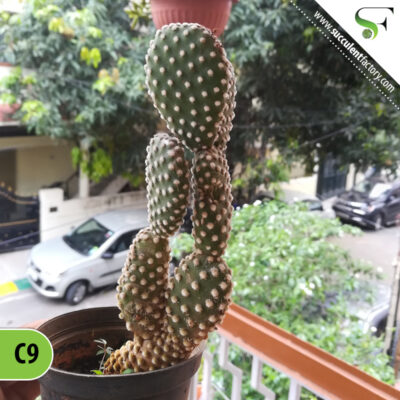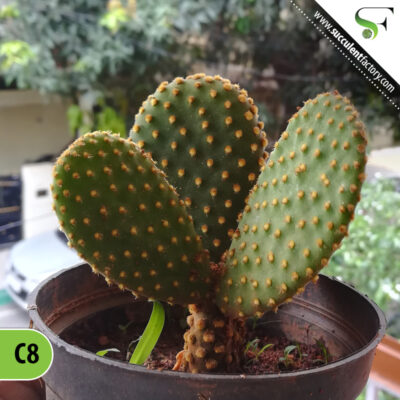-
Sale!

₹300.00 Original price was: ₹300.00.₹199.00Current price is: ₹199.00.
Austrocylindropuntia shaferi: A Striking Cylindrical Cactus from South America
Austrocylindropuntia shaferi, previously known as Opuntia shaferi, is a captivating succulent cactus native to Argentina and Bolivia in South America. It’s prized for its unique cylindrical form, vibrant flowers, and resilience in dry environments.
ALL THE PLANTS WILL BE SENT BARE ROOTED. NO SOIL NO POT
-
Sale!

₹125.00 Original price was: ₹125.00.₹99.00Current price is: ₹99.00.
-
Sale!

₹150.00 Original price was: ₹150.00.₹99.00Current price is: ₹99.00.
Mammillaria elongata, also known as Ladyfinger cactus or Golden Stars, is a popular species of cactus native to Mexico. Here are some details and growing tips for this particular cactus:
Description:
- Mammillaria elongata has slender cylindrical stems that can grow up to 6 inches (15 cm) tall and 1 inch (2.5 cm) in diameter.
- The stems are covered in tightly packed clusters of small, golden-yellow spines.
- In the spring, it produces small, pale yellow flowers that emerge from the top of the stems.
ALL THE PLANTS WILL BE SENT BARE ROOTED. NO SOIL NO POT
-
Sale!

₹300.00 Original price was: ₹300.00.₹199.00Current price is: ₹199.00.
The Euphorbia Stenoclada Silver, also commonly known as the Silver Thicket or Pencil Euphorbia, is a stunning succulent shrub or small tree prized for its architectural form, silvery-gray foliage, and interesting growth pattern. Here’s a breakdown of its characteristics and how to keep it thriving:
Description:
- Foliage: Unlike most Euphorbias, the Stenoclada Silver lacks true leaves. Instead, it boasts fleshy, flattened, and pencil-like stems that grow upright and branch out densely.
- Color: The new growth starts a vibrant green but matures to a beautiful silvery-gray or blue-gray hue. This silver color adds a unique and eye-catching element to your space.
- Spines: Be cautious, as the stems have pairs of short, dark spines at the tips.
- Size: The Euphorbia Stenoclada Silver can grow up to 12 feet (3.5 meters) tall and 4-6 feet (1.2-1.8 meters) wide, with a mature plant forming a captivating, multi-branched structure. Indoors, it will likely be more compact.
ALL THE PLANTS WILL BE SENT BARE ROOTED. NO SOIL NO POT
-
Sale!

₹300.00 Original price was: ₹300.00.₹199.00Current price is: ₹199.00.
-
Sale!

₹299.00 Original price was: ₹299.00.₹199.00Current price is: ₹199.00.
-
Sale!

₹300.00 Original price was: ₹300.00.₹149.00Current price is: ₹149.00.
Opuntia, commonly known as the prickly pear cactus, is a genus of cacti native to North and South America. They are known for their flat, paddle-shaped pads covered in spines and glochids (tiny barbed hairs). Opuntias come in a wide variety of shapes, sizes, and colors, making them popular choices for both indoor and outdoor gardens.
Here’s a closer look at Opuntia cactus and how to care for them:
Description:
- Pads: The most distinctive feature of Opuntia is its flattened pads, also known as stems or cladodes. These pads can be oval, circular, or oblong, depending on the species. The size of the pads can also vary greatly, ranging from just a few inches to several feet in length.
- Spines: Most Opuntia species have spines, which are sharp outgrowths from the pads. Spines can help to protect the cactus from predators and herbivores.
- Glochids: In addition to spines, many Opuntia species also have glochids. Glochids are tiny barbed hairs that can easily detach from the cactus and become lodged in skin or fur. They can be very irritating, so it is important to handle Opuntia with care.
- Flowers: Opuntia cacti produce flowers in a variety of colors, including yellow, orange, red, and purple. The flowers are typically large and showy, and they can bloom in spring, summer, or fall.
- Fruit: After flowering, Opuntia cacti produce fruit, which is known as a prickly pear. The fruit can be eaten, and it is a good source of vitamin C and fiber.
ALL THE PLANTS WILL BE SENT BARE ROOTED. NO SOIL NO POT
-
Sale!

₹99.00 Original price was: ₹99.00.₹39.00Current price is: ₹39.00.
Opuntia Tuna Monstrose, also known as the Prickly Pear Cactus or Bunny Ears Cactus, is a unique and visually striking succulent that’s relatively easy to grow with proper care. Here’s an introduction to this fascinating plant along with some tips to help you cultivate it successfully:
- Opuntia Tuna Monstrose is a cultivar of the Opuntia genus, characterized by its flattened, pad-like stems that resemble bunny ears or pancakes.
- It’s native to Mexico but is now grown in various regions around the world, especially in arid and semi-arid climates.
- This cactus typically grows low to the ground, forming dense mats or clumps over time.
- It produces vibrant, showy flowers in shades of yellow, orange, or pink during the spring and summer months, adding to its ornamental appeal.
ALL THE PLANTS WILL BE SENT BARE ROOTED. NO SOIL NO POT
-
Sale!

₹300.00 Original price was: ₹300.00.₹149.00Current price is: ₹149.00.
Opuntia, commonly known as the prickly pear cactus, is a genus of cacti native to North and South America. They are known for their flat, paddle-shaped pads covered in spines and glochids (tiny barbed hairs). Opuntias come in a wide variety of shapes, sizes, and colors, making them popular choices for both indoor and outdoor gardens.
Here’s a closer look at Opuntia cactus and how to care for them:
Description:
- Pads: The most distinctive feature of Opuntia is its flattened pads, also known as stems or cladodes. These pads can be oval, circular, or oblong, depending on the species. The size of the pads can also vary greatly, ranging from just a few inches to several feet in length.
- Spines: Most Opuntia species have spines, which are sharp outgrowths from the pads. Spines can help to protect the cactus from predators and herbivores.
- Glochids: In addition to spines, many Opuntia species also have glochids. Glochids are tiny barbed hairs that can easily detach from the cactus and become lodged in skin or fur. They can be very irritating, so it is important to handle Opuntia with care.
- Flowers: Opuntia cacti produce flowers in a variety of colors, including yellow, orange, red, and purple. The flowers are typically large and showy, and they can bloom in spring, summer, or fall.
- Fruit: After flowering, Opuntia cacti produce fruit, which is known as a prickly pear. The fruit can be eaten, and it is a good source of vitamin C and fiber.
ALL THE PLANTS WILL BE SENT BARE ROOTED. NO SOIL NO POT
-
Sale!

₹300.00 Original price was: ₹300.00.₹149.00Current price is: ₹149.00.
Opuntia, commonly known as the prickly pear cactus, is a genus of cacti native to North and South America. They are known for their flat, paddle-shaped pads covered in spines and glochids (tiny barbed hairs). Opuntias come in a wide variety of shapes, sizes, and colors, making them popular choices for both indoor and outdoor gardens.
Here’s a closer look at Opuntia cactus and how to care for them:
Description:
- Pads: The most distinctive feature of Opuntia is its flattened pads, also known as stems or cladodes. These pads can be oval, circular, or oblong, depending on the species. The size of the pads can also vary greatly, ranging from just a few inches to several feet in length.
- Spines: Most Opuntia species have spines, which are sharp outgrowths from the pads. Spines can help to protect the cactus from predators and herbivores.
- Glochids: In addition to spines, many Opuntia species also have glochids. Glochids are tiny barbed hairs that can easily detach from the cactus and become lodged in skin or fur. They can be very irritating, so it is important to handle Opuntia with care.
- Flowers: Opuntia cacti produce flowers in a variety of colors, including yellow, orange, red, and purple. The flowers are typically large and showy, and they can bloom in spring, summer, or fall.
- Fruit: After flowering, Opuntia cacti produce fruit, which is known as a prickly pear. The fruit can be eaten, and it is a good source of vitamin C and fiber.
ALL THE PLANTS WILL BE SENT BARE ROOTED. NO SOIL NO POT
-
Sale!

₹150.00 Original price was: ₹150.00.₹99.00Current price is: ₹99.00.
The Penicil Cholla Cactus, also known as Cylindropuntia ramosissima or Pencil Cholla, is a type of cholla cactus native to the southwestern United States and northern Mexico. Here are some details and growing tips for this unique cactus:
Description:
- The Penicil Cholla Cactus typically has a shrub-like appearance, with cylindrical segments (or joints) that are covered in spines.
- These segments vary in color from green to gray-green, and they can reach lengths of up to 3 inches (7.5 cm).
- The spines are densely packed and can range in color from yellow to reddish-brown. They are barbed and easily detach when touched, so caution is advised when handling this cactus.
ALL THE PLANTS WILL BE SENT BARE ROOTED. NO SOIL NO POT











